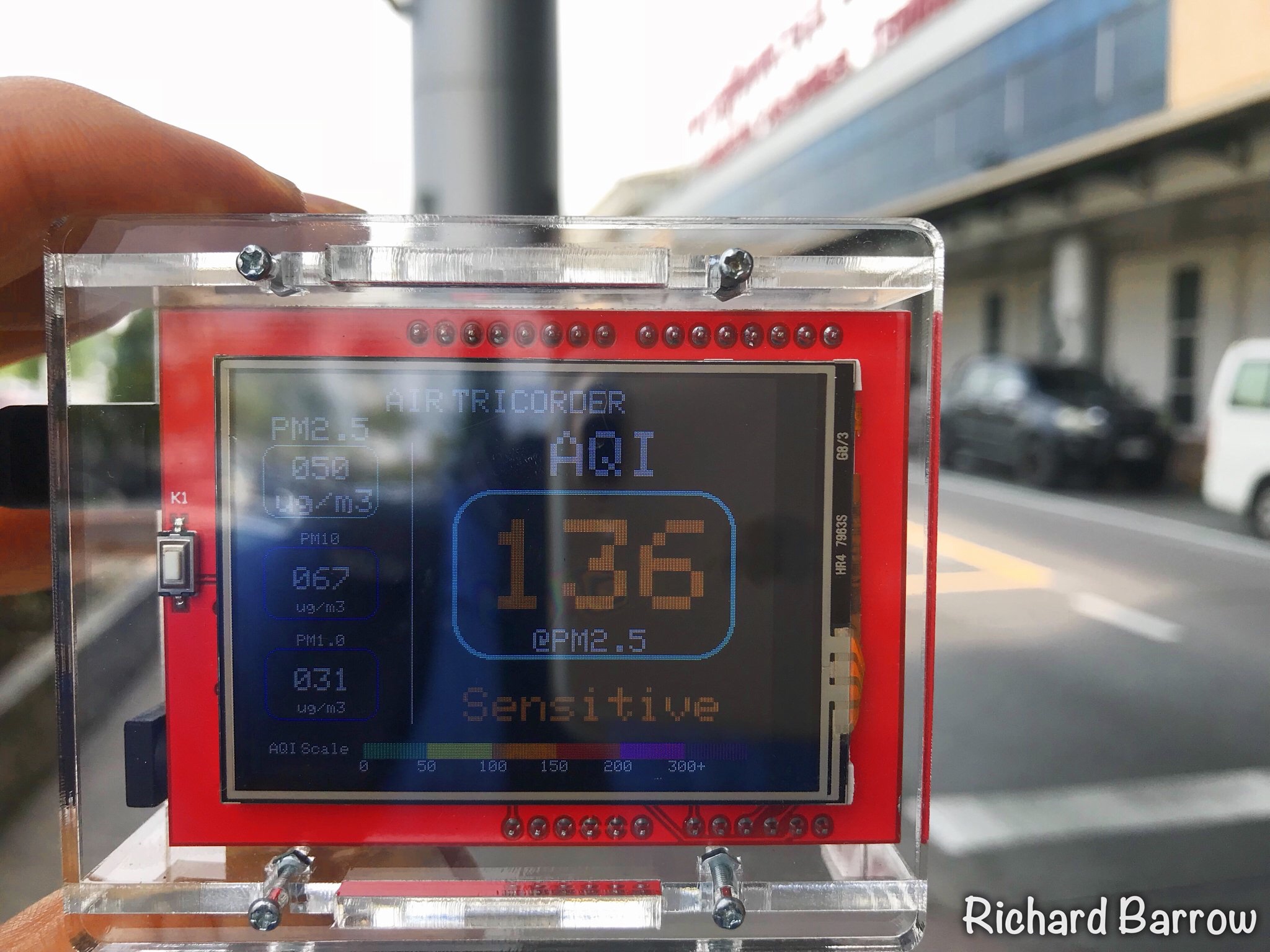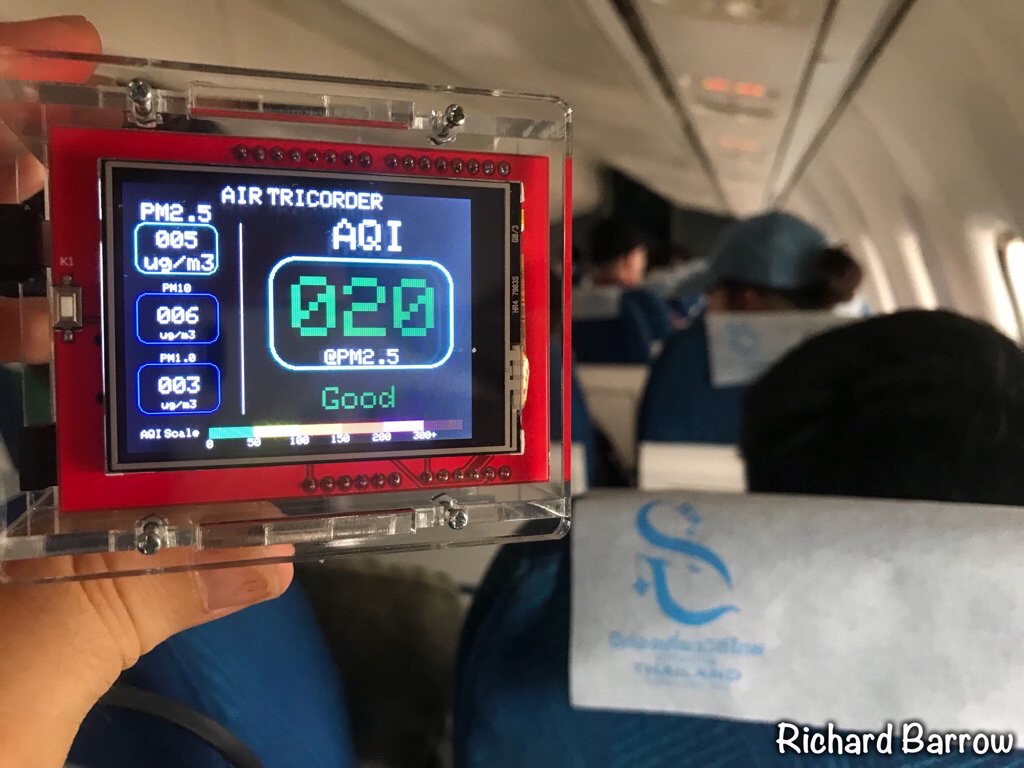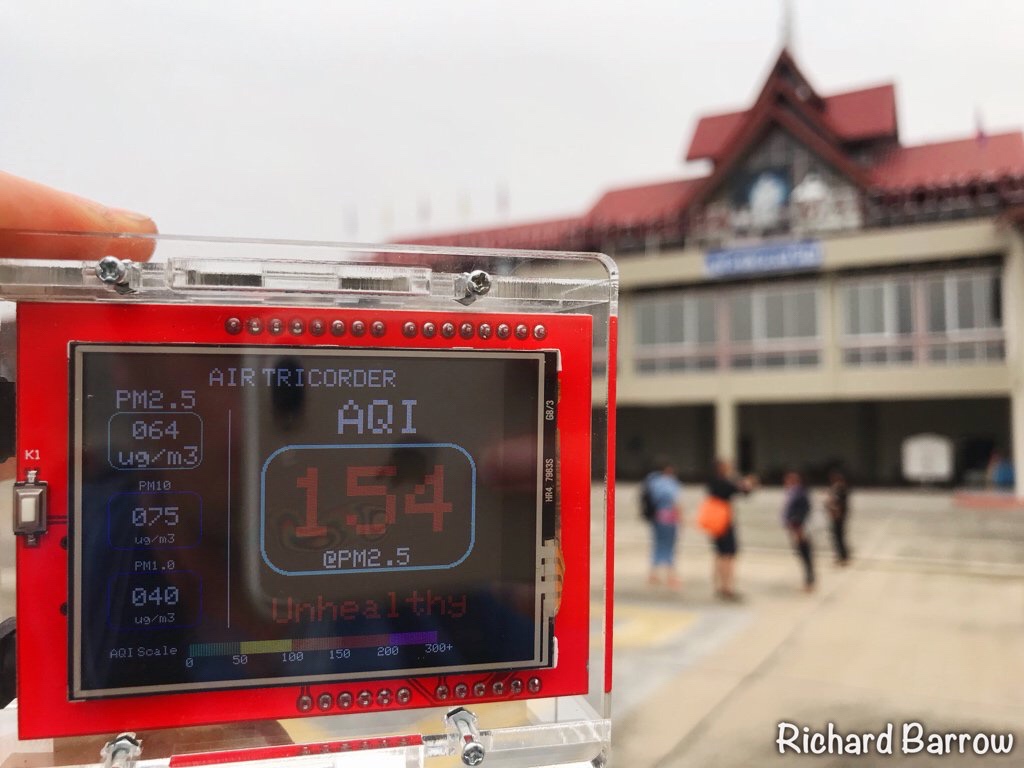Review of the Air Tricorder, a Portable AQI Sensor
The ongoing smog situation in Thailand has made people more aware of the quality of the air that they breathe. Just because you cannot always see it, it doesn’t mean that the air is clean. Some dust particles are smaller than a single hair. It’s these ones that can seriously damage your health. In order to check the air, you need an air quality monitor. In particular one that can check for PM2.5 particles.
As you are probably aware, I bought a Mi Air Purifier 2 last month (see review here). Then last week I came across an AQI sensor that had been made at Makerspace Thailand in Chiang Mai. They call themselves a “prototyping and product design center”. Click here for their Facebook page. Anyway, as I have an interest now in knowing about air quality, and as I am always keen on supporting entrepreneurs, I decided to straight away buy their Air Tricorder (Portable AQI Sensor). This cost me 2,500 Baht and it was shipped to me within the week. Click here if you are interested to learn more.

Ever since I started posting pictures of the Air Tricorder on social media, people have been asking me where I bought it and how much it cost. I am really hesitant in writing a review at this time as I don’t have much experience with not only this device but also air quality sensors in general. But, what I decided to do, is to do a quick first look for people who keep asking me questions. Please don’t rush to buy this device just because I did. (I know some people have already.) Do some research first. There are other air quality monitors out there. Some cheaper and some more expensive. Two ones that get good reviews are Laser Egg 2 ($149) and AirVisual Pro ($269). I might buy one of these just to do a field test comparison. I just need to save up some money first.
Air Tricorder tests in the field: Over the next few weeks I will be testing out the air quality sensor on my trips around Thailand. Upcoming trips will be in Central, Northern, Northeastern and Western Thailand. I will post live pictures below of my tweets on @RichardBarrow. The first picture is at the top. Scroll down for the latest pictures. The review will come later, but as usual, feel free to post questions or your own experiences in the comments below.
NOTES:
- As you can see from the top picture, this is basically a kit air quality sensor. It hasn’t been mass produced. In theory, you could make yourself. There are how-to-do tutorials on the Internet.
- There is no built in power source. You have to use a USB cable to either plug it into a power bank or into the wall with a USB plug adaptor.
- The micro USB socket on the device is on the board and seems delicate. I can see it breaking if you try and force it. So I decided to keep the cable plugged in that end all the time.
- As you can see from some of the pictures below, the LCD display is not very clear outside. Even inside, you have to look at the screen directly to read the numbers.
29th March 2018: The Air Quality Index on the waterfront in Samut Prakan is 95 (PM2.5) which is only just acceptable. Surprising as there’s a good southwesterly wind off the Gulf of Thailand. In comparison, the AQI in Chiang Mai is 187 which is definitely unhealthy.

31st March 2018: This is the Air Quality reading at the moment after my Mi Air Purifier 2 has been turned on for about 30 minutes. It started at 110 (PM2.5).

1st April 2018: When driving your car in Bangkok traffic make sure that you set the A/C to recirculate the air. I’m getting an Air Quality reading of 169. Before I switched the setting, it was 55 in my car. If you’re on a motorcycle or in a Tuk Tuk you should be wearing a mask for sure.

1st April 2018: Even in the middle of Bangkok’s Benchakiti Park you cannot escape the smog. At 141 (PM2.5), the tiny dust particles are dangerous for people in sensitive groups. In contrast, Southern Thailand is less than 30 (PM2.5).

2 April 2018: Just landed at Chiang Mai airport. The Air Quality sensor reading inside the Air Asia plane looks good. But let’s see what happens when they open the doors.

As soon as they opened the doors and I entered Chiang Mai airport, the reading shot up to 101 (PM2.5). But still inside the airport building. So only dangerous to sensitive groups like people with asthma.

Air Quality reading outside Chiang Mai airport is 136 (PM2.5). Although it’s high, there is no need for a mask unless you are from a sensitive group. For example, people with asthma.

Air quality reading inside the Bangkok Airways plane as we landed in Mae Hong Son was 20 (good) and then 154 (unhealthy) on the tarmac. At this level, everyone should limit prolonged outdoor exertion.


The Air Quality reading in my hotel room in Mae Hong Son is an unhealthy 152. The door has been closed and the a/c on for about half an hour. They say mornings are worse. Hopefully it will rain tonight. I’ve already started coughing a little.

More pictures to come soon or follow me on Twitter @RichardBarrow for live reports.



This looks like a nicely-packaged device that displays the basics (PM2.5) in particulate monitoring. But it’s not clear that the “AQI” measurement is at all accurate or useful, as the standard in the US (and most countries) is an average of hourly readings over 24 hours. Is this device really doing this? Or is the “AQI” shown here actually just the realtime PM2.5 reading represented as an official AQI measurement? Please clarify as the device is not really useful at its design point if the AQI is not done correctly.
It’s a live reading as is most other handheld devices.
Does anyone know if it’s easy to setup this measurement tool and connect to wifi, maybe via a raspberry Pi?
Great stuff, but what do use use for an air purifier?
Sorry if you already posted something about that.
I like this article Richard, however, I would like to draw attention to one particular point. That is that you keep referring to PM2.5 readings that are in fact overall air quality readings combining other pollutants. Therefore, it is an air quality index reading, not solely based on PM2.5.
As some stations do not record other pollutants, I believe that readings based solely on PM2.5 offer a better indication of the levels of most dangerous pollution in the air and provide a better argument for measuring levels of pollution consistently.
Also, it would be interesting to know how many reporting stations in Bangkok report from inside or outside buildings.
To test the accuracy you could compare the reading to the nearest official measuring station.
It would also be nice to get measurements of air in gyms and other places where people exercise and breathe heavily.
Gyms and other public places (indoors) are a good point!
I took my Tricorder to my gym in Sukhumvit area last Monday. Result: around 140 in the air-conditioned “cold zone”, over 150 in the “hot zone” (fans only)!
Also, shockingly high readings inside shopping malls; 136 in the food court of a certain big mall on Suk, around 120-130 near the elevators on the ground floor of the same mall. Do those freezing-cold aircons have any filter at all?
the filters in aircons are only for filtering out dust particles, not harmful micro particles like PM2.5 that can enter into your bloodstream.
Sure, standard filters won’t, but aircons can be retrofitted with HEPA-type filters. No idea though how much they can reduce the concentration of harmful particles in huge spaces.
Bottom line is: most people are certainly not aware of how high the concentration of particulate matter on bad air days is INSIDE seemingly clean and safe areas, such as malls, schools, gyms… Or inside their own homes, if no strong air purifier is running.
You can get an almost identical one on AliExpress for less than half the price:
https://m.aliexpress.com/item/32846369872.html
I use app https://www.airvisual.com/
Yes, but they don’t have sensors everywhere. My city doesn’t have any. Hence the need to have your own.
Did you do any side by side comparisons with other particle counters to test the accuracy of the tricorder?
Really surprised at the reading from Samut Prakan waterside. Would love to test our air here at Na-jomtien, hopefully it would be much cleaner.
That’s assuming the device is accurate. The reading is meaningless otherwise.
I have tested the LE, LE2, the Node and several Chinese air quality monitors outside. All different numbers. You can try to calibrate them by standing outside the US Embassy and compare.
For testing, Dylos is a must have. I did not purchasing it since it needs to be sent for calibration all the time.
2500 baht is about the price of a LE 1 when I first got them in Shanghai. Can you find out which sensor they use? Also, can you connect to an app or gather the data?
Would like to get a couple for Vietnam?
i wonder what the number is in Pattaya ??
Richard, interesting survey you are performing. It applies not only Thailand. But the entire world. Even more important for places with low or zero pollution. So they can prevent on time, taken expensive solutions.
Thanks for sharing !
The air was intolerable Pattaya during the last three weeks of January this year … I have NEVER experienced such polluted air … I hoped rain would clear it up … it rained and the rain had NO IMPACT on the smoke in the air